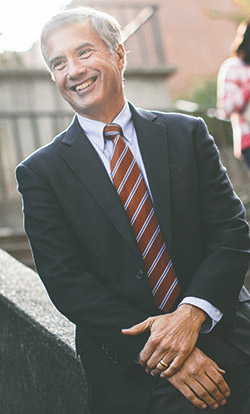Preparing to Flourish With Our Strategic Plan
By Jeff Van Duzer
 Jeff Van Duzer is provost at
Seattle Pacific University.
Jeff Van Duzer is provost at
Seattle Pacific University.
Opinions on the future of higher education are mixed. Some predict massive disruptive changes that will radically remake the university experience as we know it. Others argue that our current approach to teaching is optimal for student learning and will remain sufficiently affordable to allow universities to continue to function in the future more or less as they have since the Middle Ages.
So how do we prepare to flourish in the face of this uncertain pedagogical future? At SPU we have adopted a three-pronged innovation strategy.
First, we are working hard to get better at what we already do. Even if our pedagogical approach remains essentially unchanged, we are committed to doing it better. We spend time and resources measuring student learning. We collect data on what works and what doesn’t, and then, based on this data, adjust our practices to optimize student success.
At the course level, for example, one assignment might be swapped out for a more effective replacement; at a curricular level, the order of courses might be rearranged so students can progress easily from one course to the next.
Second, we are making certain incremental innovations, moving beyond simply getting better at what we already do by adding new features to our programs.
Here, we anticipate the plans that are emerging from the global, vocation, and reconciliation task forces. This midtier level of innovation includes Seattle Pacific’s recent development of interdisciplinary majors and expansion of our service learning courses.
But we are also experimenting on a higher level with what might end up proving to be “disruptive” innovations that could fundamentally change the nature of the SPU student experience. To this end, a faculty-led task force on academic innovation is encouraging individuals and teams of faculty members to undertake more far-reaching experiments.
To facilitate this work, the task force has created a virtual laboratory — a “safe place” to experiment. In this laboratory, the typical advance approval needed for new courses is temporarily waived. If experiments don’t produce hoped-for results faculty members are not penalized for bad course evaluations or other consequences.
These experiments are supported by a substantial University innovation fund. So far, Seattle Pacific has awarded approximately $150,000 in innovation grants. Funded experiments include novel ideas like experiments in “gamification” (teaching STEM through computer games), a hybrid course pairing online faculty instruction with a student advisor, and the redesign of a marketing concentration around a problem-based curriculum.
The success of these experiments will be assessed against the “3-E test”: Is the new pedagogy more effective in achieving the student outcomes we are looking for?
Is the new pedagogy more efficient? That is, can we achieve at least comparable student outcomes with a smaller investment of faculty time?
And does the new pedagogy preserve that which is essential to an SPU education? It is far too early to tell which of the many experiments will succeed. It’s also too early to tell how they might succeed — by being more efficient, more effective, or both. One thing we do know is that we are beginning to identify possibilities that look promising and possibilities that are “dead ends.”
Even if we never make wide-scale “disruptive” changes, some of what we learn from these experiments will enhance student learning and could help make SPU more affordable. And we are getting practice in thinking outside our “pedagogical boxes.”
Experimenting today will enable us to move quickly tomorrow as we respond strategically to the challenge and promise of the future.
